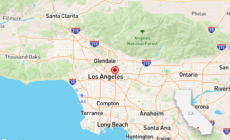-
Juan Soto Seeking More Than Money in Free Agent Discussions: Report - 9 mins ago
-
Cartel leader’s son-in-law faked death to live in California, feds say - 28 mins ago
-
Why Country Fans Are Furious Over The CMAs Toby Keith Tribute - 44 mins ago
-
Man Who Faked Kayaking Death Says in Video He’s ‘Safe’ - 45 mins ago
-
‘Doomsday fish’ washed ashore in California, but what does that mean? - about 1 hour ago
-
On Israel, the International Criminal Court Is Wrong on the Law—and the Facts | Opinion - about 1 hour ago
-
In America, if Everything Is a Public Health Crisis, Nothing Is - about 1 hour ago
-
The Mountain fire was the third most destructive wildfire in a decade. These maps show why - 2 hours ago
-
Map Shows Most Popular Relocation Countries for Blue-State Residents - 2 hours ago
-
Jussie Smollett’s Conviction for False Hate Crime Claim Is Overturned - 2 hours ago
Scientists Solve Mystery of ‘Gigantic’ Northern Lights
Scientists have finally solved the case of a bizarrely massive, smooth aurora that lit up the Arctic skies in December 2022.
This aurora is a special form of northern lights known as a polar rain aurora, which is an extremely rare type of space weather.
Usually invisible to the naked eye, the polar rain aurora was visible thanks to abnormally low solar wind levels, according to a new paper in the journal Science Advances.
Usually, auroras are created by charged particles from the solar wind or coronal mass ejections being funneled by the Earth’s magnetic field toward the poles, hitting our atmosphere in a ring shape around the north and pole poles. When these high-energy particles collide with atoms and molecules in the Earth’s upper atmosphere, primarily oxygen and nitrogen, they transfer energy to these atmospheric particles and cause them to glow in the spectacular colors associated with the northern lights.
Polar rain auroras, on the other hand, occur in the polar regions within the usual ring around the pole and appear as a diffuse, faint, and continuous glow rather than the more vibrant and dynamic displays associated with other types of auroras. Unlike other auroras, which are often triggered by geomagnetic storms and more intense solar activity, polar rain auroras can occur continuously and are not necessarily linked to such storms.

ISTOCK / GETTY IMAGES PLUS
These auroras are created when particles from the sun’s electrons travel directly from the sun’s corona along a magnetic field line heading directly toward the Earth’s poles.
“Revealing the origins of aurorae in Earth’s polar cap has long been a challenge since direct precipitation of energetic electrons from the magnetosphere is not always expected in this region of open magnetic field lines. Here, we introduce an exceptionally gigantic aurora filling the entire polar cap region on a day when the solar wind had almost disappeared,” the researchers explained in the paper.
“By combining ground-based and satellite observations, we proved that this unique aurora was produced by suprathermal electrons streaming directly from the sun, which is known as ‘polar rain.'”
This polar rain aurora was visible for 28 hours on December 25, 2022, due to an unusually low level of solar wind, which would usually disrupt the path of the polar rain particles from the sun.
Before now, this form of aurora had never been observed from the ground, and only seen from satellites in a handful of cases.
“We captured an extremely bright and gigantic polar rain aurora during a period of disappearance of the solar wind, which was visible even from the ground,” the researchers wrote. “The fine-scale forms of the polar rain aurora found in this study pose new puzzles and challenges in further investigation of the Sun-Earth connection.”
Do you have a tip on a science story that Newsweek should be covering? Do you have a question about northern lights? Let us know via science@newsweek.com.
Uncommon Knowledge
Newsweek is committed to challenging conventional wisdom and finding connections in the search for common ground.
Newsweek is committed to challenging conventional wisdom and finding connections in the search for common ground.
Source link




















